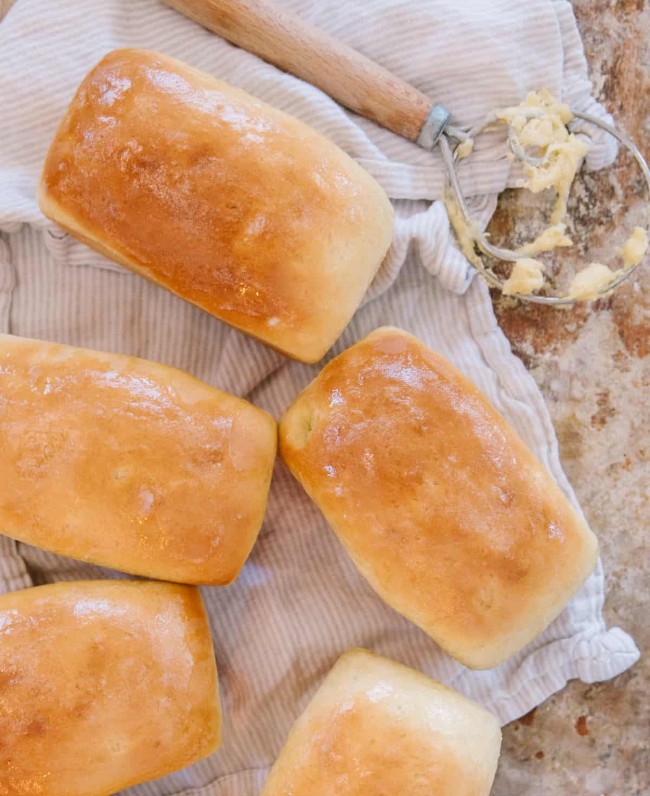The Food Nanny Kamut Bread
Rated 3.7 stars by 3064 users
Prep Time
3 hours

Ingredients
- 2 tbsp active dry yeast
- 3 cups warm water (105-115°)
- ⅔ cup honey, divided
- 7 cups White Kamut flour* , divided
- 3 ½ tbsp melted butter or olive oil
- 1 tbsp French gray coarse salt
Directions
First prepare a sponge. In a large bowl, mix together yeast, warm water, 1⁄3 cup honey and 4 cups flour. Mix with wooden spoon or dough hook until well combined. Cover with plastic (sprayed with cooking spray). Let rise for 20-30 minutes (until double in size) in a warm, draft-free place.
Add 2 ½ more cups flour along with 1⁄3 cup more honey, the melted butter or olive oil and salt. Mix well. Knead for at least 5 minutes. Add the last ½ cup flour if dough seems too sticky, 1 Tablespoon at a time. Grease bowl with cooking spray or a little olive oil. Place dough in bowl, turn and cover with a lightweight dishtowel or plastic sprayed with cooking spray. Let rise for 30 minutes (until double in size) in a warm, draft-free place.
Preheat oven to 400º. Spray pans generously with cooking spray. Six 6x3 ½ inch mini pans (or close to that size), three 8½x5 inch pans or two 9x5 ¾ inch pans. Punch down to remove air bubbles. Divide evenly and place in greased pans. Cover with a lightweight dishtowel. Let rise until double. (You know dough is ready when an indention stays after you poke the corner.)
Place pans inside of the oven when dough is ready. Turn temperature down to 350º and bake loaves. 30 minutes for large, 25-30 for medium and 17-18 for minis. Loaves are done when bottom of bread is light brown. You can tilt the hot pan just enough to check the bottom. Do not over-bake this bread or let it get too brown. Be vigilant because every oven is different.
When done, immediately invert bread pans. Place loaves on cooling rack until completely cool. If desired, brush loaves with butter. Store in bread bags or freezer bags and freeze for up to 3 months. Bread will be good for one week on the counter, refrigeration is not necessary.
Recipe Note
TROUBLESHOOTING + TIPS
Bread is deflated: It rose too long before it was placed in oven, causing it to fall hard.
Sides are blown out: It was not given enough time to rise.
Has a hole in the middle: Most likely the bread rose too fast. The place where it was rising was too warm. Yeast didn’t get a chance to fully activate. Large air pockets formed inside the dough.
Seemed a little dry: Possibly over-baked. Too much flour added while kneading.
Weather really affects bread making. Some days require less flour and others a little more. Most often the indicated amount of flour will work perfectly.
Whole grain Kamut bread did not rise as well: Whole wheat bread requires a much longer rising time, sometimes double the time.
Tip: If you have an emergency and need to stop the second rising, place covered dough in refrigerator. When you are ready to form the loaves, let dough come to room temperature. Let rise and bake as directed.
VARIATIONS
Substitute whole grain Kamut flour for white Kamut flour.
Note
Benefits to a sponge dough: your bread will stay fresh longer. This slight fermentation helps break down gluten, which is better for digestion.
You and your family will love the texture and flavor of this bread. We have been eating it for almost five years! We feel healthier and feel a deep connection to those who lived long ago. We are truly spiritually fed by eating this wonderful
ancient grain. It has made a marked difference in all our lives! Once you start baking with this flour, you will see how easy it is to work with and will want to continue using it in everything. This Kamut bread is an everyday ritual of true
and simple value.

